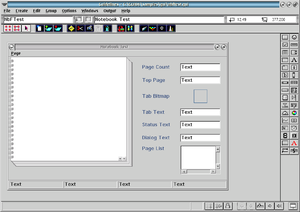JBA Guidelines: Difference between revisions
No edit summary |
|||
| (4 intermediate revisions by one other user not shown) | |||
| Line 1: | Line 1: | ||
[[Image: | [[Image:guidelines1.png|right]] | ||
C++ development environment and an application generator for OS/2 that could also generate code for MS Windows. Introduced in 1992 and originally written as a tool for developing GUI front ends for the AS/400 software products from the [[JBA Holdings]] company but was extended into a general business application development tool. | C++ development environment and an application generator for OS/2 that could also generate code for MS Windows. Introduced in 1992 and originally written as a tool for developing GUI front ends for the AS/400 software products from the [[JBA Holdings]] company but was extended into a general business application development tool. | ||
You build your application in a GUI designer then write the back end in either C++ or in a proprietary event driven fourth generation language called | ==Features== | ||
[[Image:guidelines2.png|thumb|Notebook test window on an early version of JBA Guidelines]] | |||
You build your application in a GUI designer then write the back end in either C++ or in a proprietary event driven fourth generation language called [[JOT]], Guidelines then generated C++ code from your front-end design and JOT code and you compiled it with your choice of C++ compatible compiler suite, or had Guidelines do it for you. In addition the company offered optional Client/Server back ends for AS/400, Unix SQL servers and ODBC. | |||
Version 3.3 introduced quite advanced support for CORBA object message passing, including over a network (Distributed object message passing). | Version 3.3 introduced quite advanced support for CORBA object message passing, including over a network (Distributed object message passing). | ||
While Guidelines did nothing in the OS/2 or Windows marketplaces it survived as an in house tool and was used for most PC system development at the company, however a number of people hacked the Guidelines package to act as a GUI builder for other systems, the first version of ''Visual Ada Developer'' used the package as its front end for instance. | While Guidelines did nothing in the OS/2 or Windows marketplaces it survived as an in house tool and was used for most PC system development at the company, however a number of people hacked the Guidelines package to act as a GUI builder for other systems, the first version of ''Visual Ada Developer'' used the package as its front end for instance. | ||
==Version== | ==Version== | ||
* 2.0G | |||
* 2.1A (Apr 1994) | |||
* 3.1A (Jul 1995) | * 3.1A (Jul 1995) | ||
* 3.2 | * 3.2 | ||
| Line 27: | Line 31: | ||
==Links== | ==Links== | ||
* | * {{FileLink|GuideLines_3-1.zip}}. Demo version of Guidelines 3.1 | ||
* | * {{FileLink|TeachGuidelinesIn21Days_1995-07-16.zip}}. Teach yourself JBA Guidelines in 21 days by mtalexa@ibm.net | ||
==License== | ==License== | ||
Latest revision as of 16:11, 27 January 2024

C++ development environment and an application generator for OS/2 that could also generate code for MS Windows. Introduced in 1992 and originally written as a tool for developing GUI front ends for the AS/400 software products from the JBA Holdings company but was extended into a general business application development tool.
Features

You build your application in a GUI designer then write the back end in either C++ or in a proprietary event driven fourth generation language called JOT, Guidelines then generated C++ code from your front-end design and JOT code and you compiled it with your choice of C++ compatible compiler suite, or had Guidelines do it for you. In addition the company offered optional Client/Server back ends for AS/400, Unix SQL servers and ODBC.
Version 3.3 introduced quite advanced support for CORBA object message passing, including over a network (Distributed object message passing).
While Guidelines did nothing in the OS/2 or Windows marketplaces it survived as an in house tool and was used for most PC system development at the company, however a number of people hacked the Guidelines package to act as a GUI builder for other systems, the first version of Visual Ada Developer used the package as its front end for instance.
Version
- 2.0G
- 2.1A (Apr 1994)
- 3.1A (Jul 1995)
- 3.2
- 3.3 (1996)
- Prerequisites
- OS/2 2.1 or higher
One of the following C++ compiler products:
Early versions of the software required IBM C Set++ 2.01 or IBM VisualAge C++ 3.0 and the OS/2 Developer's Toolkit to compile the Guidelines output, later versions don't support C Set.
EDM/2 Articles
- Brad Scharf: Under the Scope (Feb 1996) - Guidelines 3.1j
- Brad Scharf: Under the Scope (May 1996) - Guidelines 3.2
Links
- GuideLines_3-1.zip. Demo version of Guidelines 3.1
- TeachGuidelinesIn21Days_1995-07-16.zip. Teach yourself JBA Guidelines in 21 days by mtalexa@ibm.net
License
- Commercial
The retail price for JBA Guidelines was:
- Guidelines Base pack: Free - Essentially a GUI creator without any background C++ generation, so both functional as a small time GUI creator and as a demo for the full package.
- Professional Developers Kit $595
- Client/Server Connectivity $995
- MS Windows Code Generation $395
- Database Connectivity Pack (ODBC) $395
- Lotus Notes Support Pack $99
or
- Guidelines for Corporate Developers $7750 per seat.